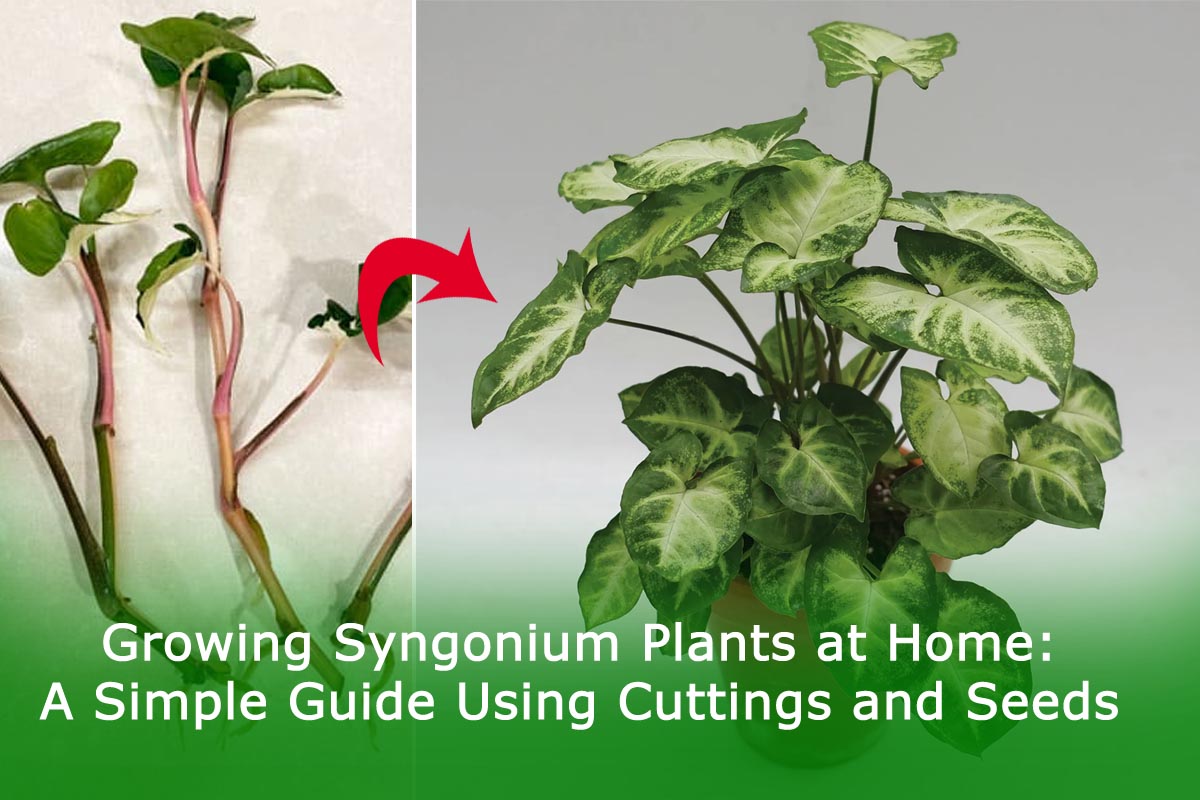
Growing Syngonium Plants at Home: A Simple Guide Using Cuttings and Seeds
Syngonium is an excellent air-purifying plant that can be easily kept in any corner of your home. Plants control the house clean and have become an essential part of home decor, enhancing the beauty of your living space. Syngonium, scientifically known as Syngonium podophyllum, is a top-notch indoor plant that people also use for freshening indoor air.
Rapidly growing in regions with high rainfall, such as Mexico, the West Indies, and South America, this plant is recognized for its positive energy and stress-relieving qualities. It is believed to absorb positive energy and keep various stresses and worries at bay. If you wish to add this plant to your home, you can easily do so. Additionally, it thrives in soil and water, making it a hassle-free addition to your indoor garden. Let’s explore some easy tips for planting Syngonium.
Materials for Growing Syngonium Plants at Home
- Cutting or Seeds of the Syngonium plant
- Pot or Planter
- Potting Soil
- Fertilizer
- Water
Also Read This : Top 20 Low-Maintenance Hanging Plants for Your Home
Planting Procedure
To plant a Syngonium:
- Start by choosing a medium to large-sized pot according to your preference.
- Mix 50% coco peat and 50% vermicompost (earthworm castings or manure) thoroughly.
- Fill the pot with this potting mix.
- Once the potting mix is ready, take the cutting or seeds of the Syngonium plant. If using cuttings, make a slanting cut while taking the stem and plant it in the pot. If using seeds, sow them in the pot.
- After planting the cutting or seeds, it’s time to water the pot. Ensure you water it adequately, providing the right amount of moisture for the plant to thrive.
Also Read This : Indoor Plants that Grow in Water and Easy to Manage
How to Care for Syngonium Plants
Syngonium plants are a joy to cultivate due to their ease of growth and low maintenance requirements. Available in various colours, these plants add a beautiful touch to indoor spaces and are known for their versatility, thriving in multiple conditions.
Light:
Place your Syngonium plants in bright, filtered sunlight for optimal growth and aesthetics. Avoid exposing them to direct sunlight or positioning them near AC vents, which can lead to leaf burns.
Also Read This : Tips for Plantation Grow These Plants in Water
Water:
Syngonium plants do not demand frequent watering, so it’s essential to maintain a moderate watering routine. Water them only when the topsoil partially dries out, especially in well-lit, shaded areas during the summer. Avoid letting the Syngonium plant completely dry out for extended periods, which can result in dehydration.
Pruning:
Without regular pruning, Syngonium plants can quickly become climbers. If you prefer a compact tabletop plant or want to control vine growth, prune it regularly to maintain its desired shape. For longer vines, consider placing them in hanging pots.
Also Read This : The Ultimate Plants to Decorate Office Desk and Home Space
Fertilization:
Avoid over-fertilizing your Syngonium plants, as excessive fertilizer can harm the roots. Opt for a balanced liquid fertilizer and feed them only once during the main growing seasons, such as summer and spring. Refrain from fertilizing them in winter when growth slows down, as the plant may struggle to reach its full potential.
Also Read This : Right Direction to Keep Tulsi Plant in Your Home
FAQs about Growing and Caring for Syngonium Plants
Q: Can Syngonium plants be grown outdoors?
Syngonium plants are well-suited for indoor environments. While they can be grown outdoors in certain climates, they thrive best as indoor plants in most regions.
Q: How often should I water my Syngonium plant?
Watering frequency depends on factors like light exposure and temperature. Generally, water is used when the topsoil is partially dry. Avoid overwatering and allow the soil to dry out between watering sessions.
Q: Can Syngonium plants tolerate direct sunlight?
Syngonium plants prefer bright, filtered sunlight. Direct sunlight can lead to leaf burns, so it’s best to place them in well-lit areas without direct exposure to the sun.
Q: Is pruning necessary for Syngonium plants?
A: Pruning is beneficial to control the growth of Syngonium plants. Regular pruning helps maintain a compact shape, and for longer vines, consider placing them in hanging pots.
Q: What type of fertilizer is suitable for Syngonium plants?
Use a balanced liquid fertilizer during the main growing seasons (spring and summer). Avoid fertilizing in winter when growth slows down.
Q: Can I propagate Syngonium plants from cuttings?
Yes, Syngonium plants can be propagated from cuttings. Take stem cuttings with a node, allow them to root in water or soil, and then transplant them into a new pot.
Q: Do Syngonium plants have any specific temperature requirements?
Syngonium plants thrive in typical indoor temperatures ranging from 60°F to 75°F (15°C to 24°C). Avoid exposing them to extreme temperature fluctuations.
Q: Are there any common pests that affect Syngonium plants?
Syngonium plants may be susceptible to pests like spider mites and aphids. Regularly inspect the plants and treat any infestations promptly with appropriate measures such as insecticidal soap.
Also Read This : Botanical Bounty: Must-Have Flowering Shrubs to Transform Your Garden
Remember that specific care needs may vary based on individual conditions and plant varieties, so it’s always a good idea to observe your Syngonium plants closely and adjust care practices accordingly.
Also Read This : Exploring the Green Tapestry: All About Shrubs, Plants, and Their Types




